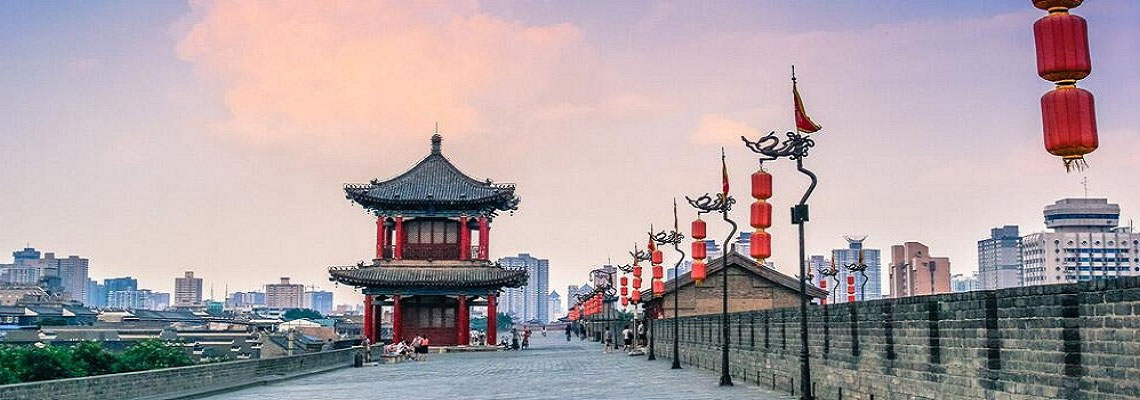
Day 1
Irkestam/Torugart Border--
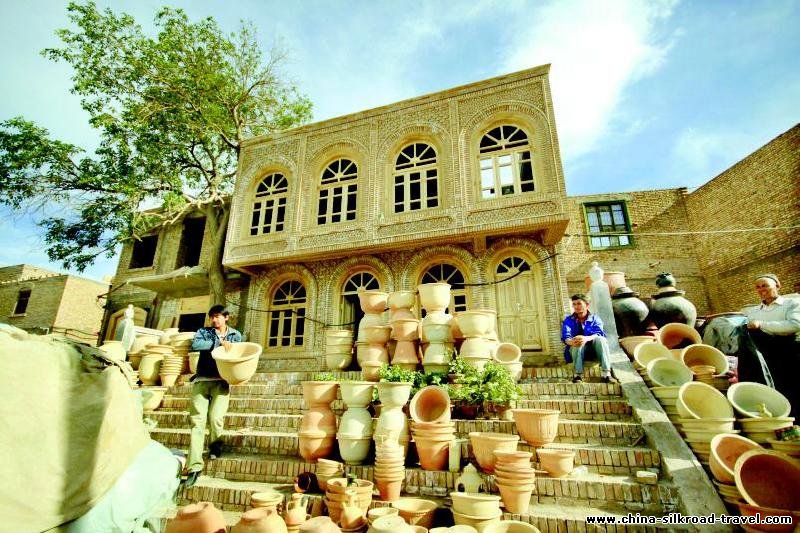
- The Pottery Workshop in Kashgar
You will drive to the Irkestam/Torgart border, custom control, and then drive to the pass where you will meet our Chinese guide and drive on to Kashgar. Crossing the "modern" frontiers is half the fun on the Silk Road today. We cross over to China and your Chinese English-speaking guide will meet you at Turgart Pass and then transfer you to head to the Silk Road centre of Kashgar. Our Chinese guide will pack lunch for you. Then you will have a 3-5 hours drive to Kashgar to start your China Silk Road Adventure. We will make sure that you will have a great silk road tour with us.
As the Kashgar Sunday bazaar is only open on Sunday and the border is closed on Sunday, we suggest that you cross the border on Friday. Please note that the border is also closed on Chinese holiday. Please check our website about the dates when the border will be closed in the year of your tour before you make the plan.
Day 2
Kashgar City Tour-
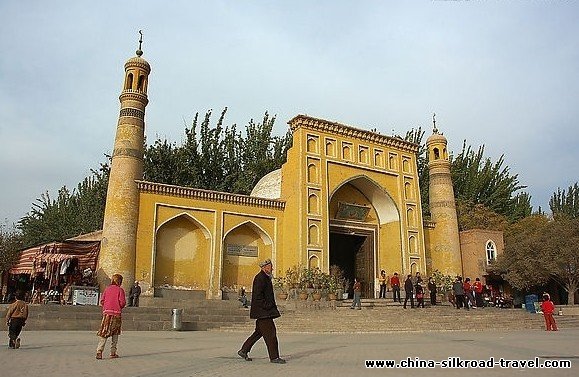 Idigar Mosque
Idigar Mosque
After breakfast we will take the city tour. We will visit the Id Kah Mosque and the Abakh Hoja Tomb. After lunch you will visit the Kashgar Old Town.
Id Kah Mosque: This is the largest mosque in China, and the most famous mosque in Xinjiang. The construction of the mosque started in the middle of the 15th century, and the mosque has gradually developed to its present size. The buildings of Id Kah Mosque look magnificent and solemn, and display the artistic styles of Islamic mosque architecture. The Mosque has an area of about 16,800 square meters, consisting of the Pray Hall, the Koran teaching Hall, the Corridor, the Arches and other buildings attaching to it. The Pray Hall of the mosque, which can hold 4,000 prayers, is supported by 140 carved wooden pillars.
Apakh Hoja Tomb: This Mazar is the holiest place in Xinjiang for the Muslims, and an architectural treasure. Built in 1640, it is reminiscent of the Central Asian artistic style of Samarkand or Isfahan. The site is also known as the Xiang Fei (Fragrant Concubine) Tomb in memory of Abakh Khoja's granddaughter, Iparhan, who was the Fragrant Concubine of Emperor Qianlong of Qing Dynasty. A handsome blue-and-white tiled gate leads into the compound, which includes a small religious school and the Abakh Khoja family tomb. The latter is domed and faced with muti-color tiles. It is the most complete Islamic tomb dating from the beginning of the Qing Dynasty.
Old Town: Kashgar is an ancient city, and in walking the streets of its Old Town, one gets the sense of what this legendary Central Asian hub was like in the days when the Silk Road was at its zenith. 500-year old remnants of the city wall, narrow lanes and colorful multi-ethnic crowds combine to make Kashgar’s historic district a highlight of any visit to the city. Visit the small alleys to look at the characteristic Uygur residences. You will experience and enjoy the culture and history that has been retained in the small alleys and deep courtyards. In the alleys on platforms beside the residence you could marvel at the even more ancient primitive workshops for hand-made earthenware. Some 17 or 18 antique workshops have been restored.
Day 3
Kashgar-
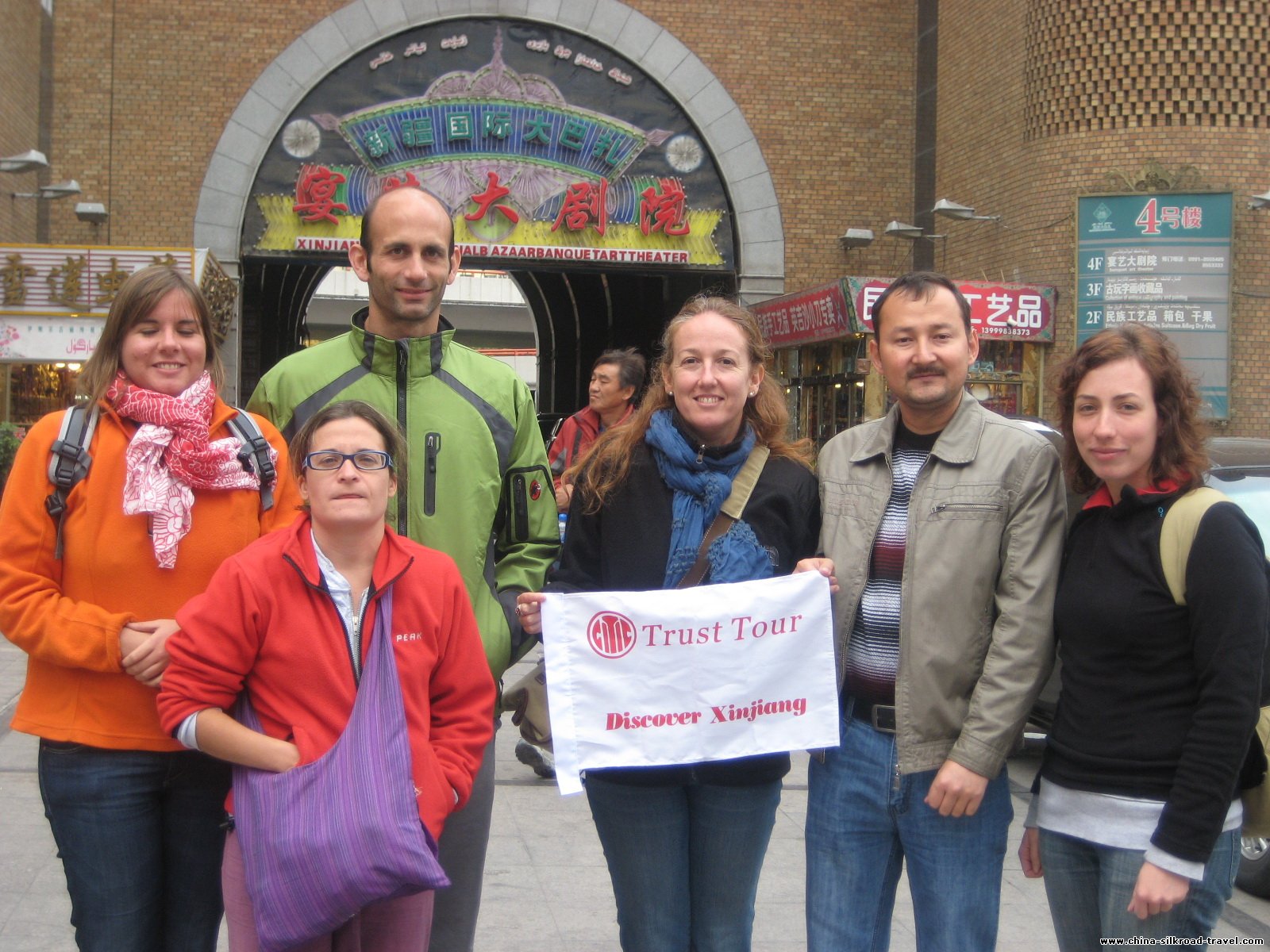 Our Travelers from Spain in the Bazaar of Urumqi
Our Travelers from Spain in the Bazaar of Urumqi
In the morning you will board a short flight to Urumqi. After lunch, we will have a short tour of Urumqi. We will visit the Xinjiang Museum (of National Minorities and History) and Erdaoqiao Market. We will also visit the Old Town area around the market to see how the Uyghurs live in today’s modern capital (New Town is the Han Chinese part of the city). After that we will drive to Turpan, which is in a land depression 505 feet below sea level. Turpan is known for its wonderful crops of grapes and melon. On the way to Urumqi, you will visit the Urumqi Wind Power Station, which is the biggest wind power station in Asia. More than 350 windmills work to provide electricity for the people of Urumqi. A wonderful Uygur dance show will be provided in the evening.
Xinjiang Museum: The Xinjiang Regional Museum is a large integrated museum and a centre for the collection and study of cultural relics in Xinjiang. The museum was built in 1953, featuring Uighur ethnic internal decor style and has an exhibition hall covering an area of about 7,800 square meters. There are more than 50,000 pieces of various kinds of cultural relics stored in the museum, among them are the ancient mummies represented by the “Loulan Beauty”, manuscripts in Chinese, Karosthi, Qiuci, Yanji, Tibetan, Uighurian and other characters prevailing in ancient western regions of China, as well as silk, wool, cotton and hemp fabrics and folk raiment, etc., all items of great intrigue. The 'Loulan beauty' mummy in particular is a well preserved mummy from 4000 years ago. It still has a reddish brown skin, thick eyelashes, charming large eyes, and long hair.
Erdaoqiao & International Bazaar: Here you will find a bustling market filled with fruits, clothing, crafts, knives, carpets, and almost anything that you can imagine. This is the largest bazaar in Urumqi, and is a place most welcomed by tourists, especially the ladies who will find they can buy some traditional Yugur cosmetics. On Sunday, there are more stalls and more goods to buy than any other day. The old streets around the bazaar are particularly worth seeing.
Day 4
Turpan--
Our Travelers from German in the Local Uighur Family
In the morning we will visit the Ruins Of Gaochang City, and the Bezklik Grottoes (Thousand Buddha Caves), which shows the extent to which Buddhism had spread in this area. We will see the Turpan Cemetery with decorated tombs dating back to the Jin and Tang dynasties more than a thousand years ago. We will stop at the ancient Astana Tombs. We will also visit the Flaming Mountains that seem on fire in the mid-day sun and the Sugong Minaret, one of the architectural gems of the Silk Road.
Before dinner, our guide will bring you to the local night market or super market to buy something to eat or drink for overnight on the train. After dinner. you will be transferred to the Daheyan train station, about an hour’s drive from Turpan city. You will then take the soft sleeper train to Dunhuang.
Ancient Gaochang City: In its heyday, the ancient city of Gaochang must have shone like a precious stone inlaid in the barren Gobi Desert on the silk road. It is located at the foot of the Flaming Mountain, about 46 km southeast of Turpan. It was initially built as a garrison town in the first century BC. It was a key point along the Silk Road. As one of the key points along the Silk Road, the ancient city of Gaochang was also a sanctuary of world religious culture. Xuanzhuang, a renown Buddhist monk during the Tang Dynasty stopped here and delivered lectures on his way to India. After 2,000 years, the weather-beaten ancient city still provides glimpses of its past greatness and glory. Even though the walls are incomplete now the magnificent outline remains. The remains standing here remind us of the grandeur and prosperity of the ancient city.
Bezeklik Grottoes: The Bezeklik Grottoes, or Thousand Buddha Caves, is a complex of Buddhist cave grottos dating from the 5th to 14th century between the cities of Turpan and Shanshan at the north-east of the Taklamakan Desert near the ancient ruins of Gaochang in the Mutou Valley. They are high on the cliffs of the west Mutou Valley under the Flaming Mountains, and most of the surviving caves date from the West Uyghur kingdom around the 10th to 13th centuries. There are 77 rock-cut caves at the site. Most have rectangular spaces with rounded arch ceilings often divided into four sections, each with a mural of the Buddha. The effect is of entire ceiling covers with hundreds of Buddha murals. Some murals show a large Buddha surrounded by other figures, including Turks, Indians and Europeans. Some of the murals are masterpieces of religious art.
Sugong Minaret: Located in Mura Village 2km to the east of the city of Turpan, the minaret tower was built in the 41st year of the long reign of Qianlong Emperor during the Qing Dynasty. It is the embodiment of the ancient architectural arts of the Uighur people. The body of the tower is cylindroid in shape, built with bricks arranged in various symmetrical patterns on the outer wall. The tower has 14 windows and a spiral staircase inside going to the top.
The Flaming Mountain: The Flaming Mountain is famously described in the classic Chinese mythological novel “Journey to the West”. It runs west from Shanshan County, is 98 km in length and 9 km across, with a relative height of 500 meters and the highest peak at 832 meters. The mountain is a branch range of the Bogda Mountain, formed in the orogenic movements of the Himalayas. This is the hottest place in China. The highest air temperature in summer is 47.8 degrees Centigrade, and the ground is over 70 degrees Centigrade in summer. Many years of volcanic activity have formed the unique crisscrossing gullies and ravines. During mid-afternoon the heat becomes intense as the sun's rays are reflected off the red rocks, as though the hillsides are engulfed by tongues of fire, hence the name.
Day 5
Dunhuang-
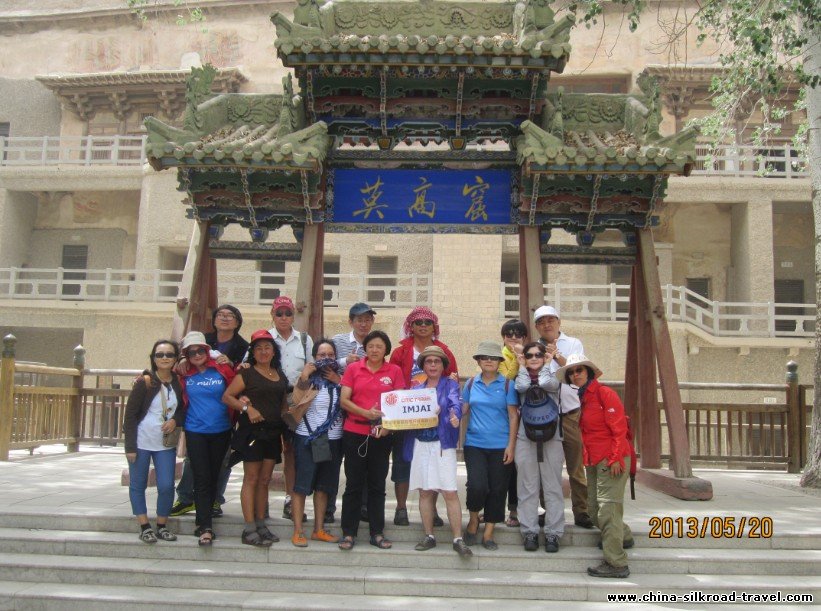 Our Travelers from Thailand in Mogao Caves
Our Travelers from Thailand in Mogao Caves
Our guide will meet you at the train station and then drive you to Dunhuang city. The drive will take about 2 hours. After breakfast we will visit the famous Mogao Grottoes , Echoing-Sand Mountain and Crescent Lake.
Mogao Grottoes: The Mogao Grottoes, a shrine of Buddhist art treasures, is 25 km from downtown Dunhuang on the eastern slope of Mingsha Shan (Echoing Sand Mountain). A network of plank-reinforced roads plying north to south 1600 meters long lead to the cave openings, which are stacked five stories high, some reaching up to 50 meters. Incidentally, Mogao means high up in the desert. According to Tang Dynasty records, a monk had witnessed onsite a vision of thousand Buddhas under showers of golden rays. Thus inspired, he started the caves construction work that spanned a millennium, from the 4th to the 14th centuries. What remains today is truly awe inspiring, and is likely the world’s richest treasure house of Buddhist sutras, murals and sculptures. Please note that cameras are not allowed inside the grottoes.
Echoing-Sand Mountain and Crescent Lake: Together with the Crescent Spring and the Mogao Caves, the Echoing-Sand Mountain is the most popular tourist site in Dunhuang. Echoing-Sand Mountain, known as Mingsha Mountain to the Chinese, is 5 km to the south of Dunhuang and is famous for the constant sound of the moving sand. Legend has it that many years ago a horrific battle was fought here, and the sounds we hear today were the haunting cries of soldiers buried in the sand dunes. Situated within the Echoing-Sand Mountain Park, the Crescent Moon Lake is literally an oasis in the desert. The lake’s name derives from the crescent moon shape taken by the pool of spring water between two large sand dunes. Although the surrounding area is very dry, the pool surprisingly doesn’t dry up as one might expect.
Day 6
Dunhuang-
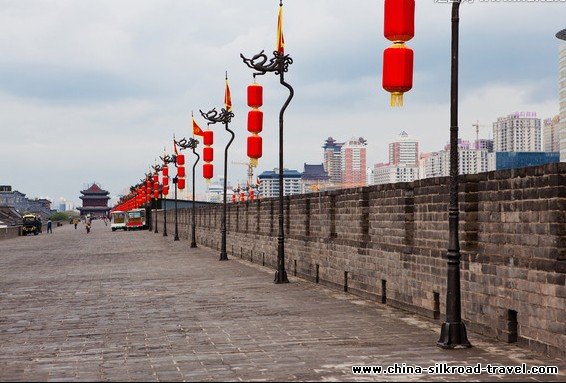 City Wall in Xi'an
City Wall in Xi'an
After breakfast you will take the soft sleeper train to Xi’an. The train ride will take a full day. You will arrive in Xi’an the next day. There is a restaurant on the train. You can have meals on the train, or you could buy some food before you board the train. Xi'an, pronounced "she-ahn" is the capital of Shaanxi province, and is the largest city in north-west China. It had served as the nation's capital for more than 1000 years. As the birthplace of Huaxia civilization, Xi’an is a city with long history and abundant cultural heritage, and is a level one national historical and cultural city. As one of the four famous ancient capitals in the world, (the other three are Rome, Cairo and Athens), Xi’an is exceptionally rich in resources for traveling and is a city that is well-known worldwide. There are more than 120 mausoleums of the emperors surrounding the Xi’an city. The Terracotta Warriors are reputed as “the eighth miracle” in the world.
Day 7
Xi’an-

- The Terracotta Warriors
Our guide will meet you at the train station and then start the full day excursion with you, but if the hotel rooms are available, we may check you into the hotel first so you can freshen up. We will visit the world-famous Terra-Cotta Warriors and Horses at the Tomb of Qin Shi Huang, the first emperor in China, and then visit Banpo Village to see the remains of a Neolithic village dating back 6,000 years. Primitive tools and household utensils are displayed in the Banpo Museum. We will return to the city and visit the Grand Mosque and the nearby Muslim living quarters. The Grand Mosque of Xian is the biggest and best preserved mosque in China. The mosque was constructed in 742AD during Tang Dynasty. It was rebuilt in the subsequent Song, Yuan, Ming and Qing dynasties. In the evening, we will attend a Tang Dynasty show and experience the glorious Tang culture. You will enjoy the royal arts like a Tang Dynasty emperor.
Day 8
Xi’an-
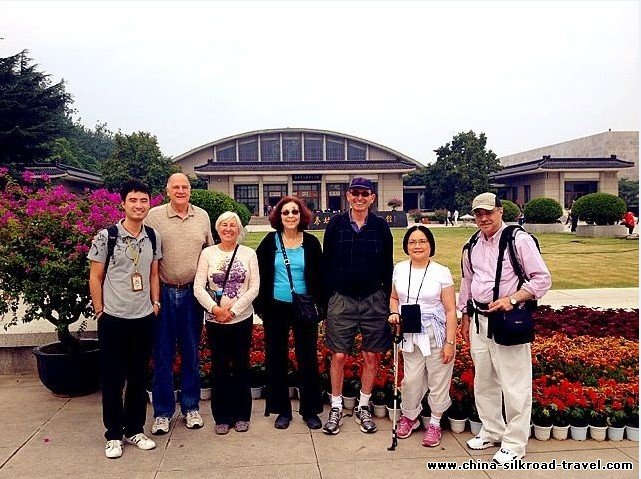
- Our Travelers from America in Shanxi Museum
After breakfast we will go on a city tour, visiting the Ancient City Wall, which was built in 1370AD, and see the North Gate Welcoming Ceremony. After that you will visit the Bell Tower which was used to keep time for the town and to sound alarms. This huge tower was originally built the 14th century, and it was relocated in 1739. In the afternoon we will visit Big Wild Goose Pagoda which was built in 652AD. It houses a large collection of Buddhist scriptures which were obtained from India by the eminent monk Xuanzang. After dinner, you will board the overnight train with soft sleeper to Beijing. Beijing is the nation's political, economic, cultural and educational center as well as China's most important center for international trade and communications. It has been the heart and soul of politics and society throughout its long history and consequently there is an unparalleled wealth of discovery to delight and intrigue travelers as they explore Beijing's ancient past and enjoy its exciting modern development.
Xian Ancient City Wall: This is an extension of the old Tang Dynasty structure boasting the most complete city wall that has survived through the long Chinese history. The City Wall has corner towers, ramparts, sentry towers, gate towers, battlements and a number of city defensive fortifications with very strong defense capability.
North Gate Welcoming Ceremony: The North Gate of the Xi’an city wall was for receiving and seeing off guests during the Tang Dynasty. It was called the first gate all over China at that time. The ceremony presented at the gate was designed after the most classic part of the welcome ceremony in the style of Tang Dynasty. It comprehensively illustrates not only the essence of the Tang-Dynasty-style etiquette but also the broadness and profoundness of the Chinese culture.
Day 9
Beijing-
 Our Travelers from America in Shanxi Museum
Our Travelers from America in Shanxi Museum
Your train will arrive in Beijing early in the morning. This will be an unforgettable day in Beijing. Escorted by our guide, you will visit the famous Great Wall at Mutianyu. The Great Wall of China is one of the Seven Wonders of the world. You will ascend one or two of its majestic towers and enjoy a unique view of the Wall winding among the undulating mountains. When you return to the city, you will take a rickshaw tour of the fascinating Hutongs - old narrow lanes lined with ancient courtyard houses, giving us a glimpse into the daily life of some of the Beijing residents. Then you will visit the Prince Gong Mansion which is the biggest quadrangle in the world and now it is the best preserved of the more than sixty princely mansions from the Qing Dynasty (1644-1911). It was once the residence of He Shen, a favorite court official during the reign of Emperor Qianlong (1735-1796). As soon as Emperor Qianlong died, He Shen was put in prison and sentenced to death for his corruption by Emperor Jiaqing, the successor of Emperor Qianlong. Thus, his residence was confiscated, and afterwards, in 1851, Emperor Xianfeng (1850-1861) gifted it to his sixth younger brother Yixin, Prince Gong. That is how the residence got its name.
Day 10
Beijing-
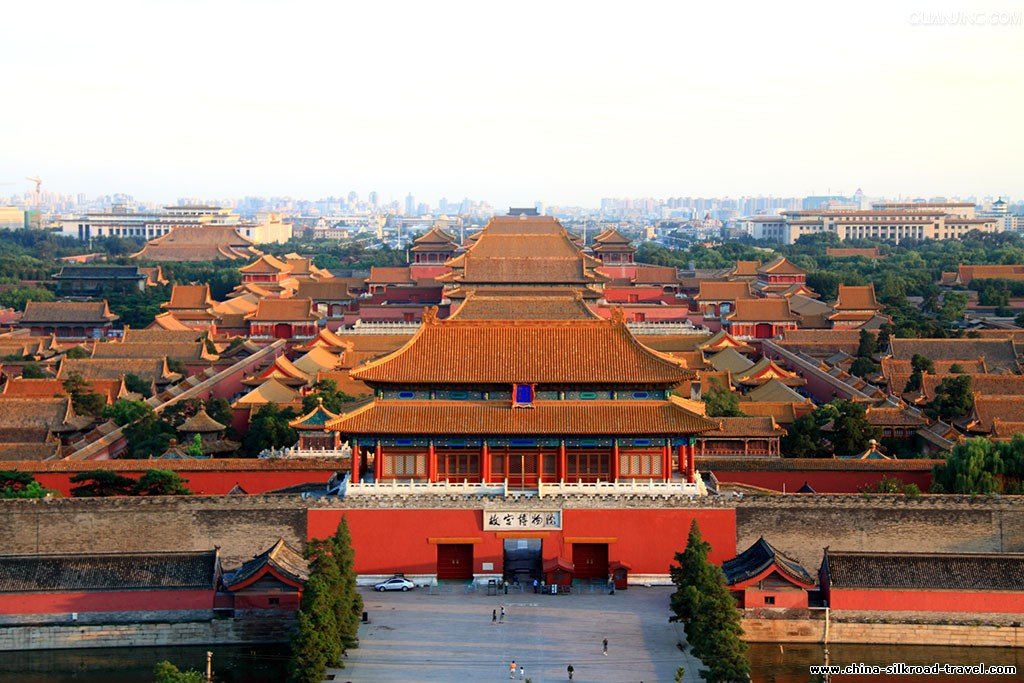 Forbidden City
Forbidden City
After breakfast we will visit the Forbidden City -- the largest imperial palace in China during the Ming and Qing dynasties with a history of around 600 years. Located in the middle of Beijing, Forbidden City was the Chinese royal palace from the Ming Dynasty to the end of the Qing Dynasty. You will also visit Tiananmen Square -- the largest city square in the world. Then you will be taken to the Bird’s Nest, the main stadium for the 2008 Olympic Games. After that we will visit the Summer Palace, the largest and most well-preserved royal park in China, which greatly influenced Chinese horticulture and landscape with its famous natural views and cultural interests. It has long since been recognized as 'The Museum of Royal Gardens'. In the evening, we will attend a farewell banquet featuring Beijing Roast Duck, specially prepared for you!
Day 11
BeijingAfter breakfast you will check out from your hotel, and your journey ends with a hotel-airport transfer.
| Travel in party of |
Superior Class ★★★★★ |
Deluxe Class ★★★★ |
Tourist Class ★★★ |
| 2-3 persons | N | $ | $ |
| 4-6 persons | N | $ | $ |
| 7-9persons | N | $ | $ |
| 10 persons & above | N | $ | $ |
| Single room Supplement | N | $ | $ |
Service included:
Service excluded:

